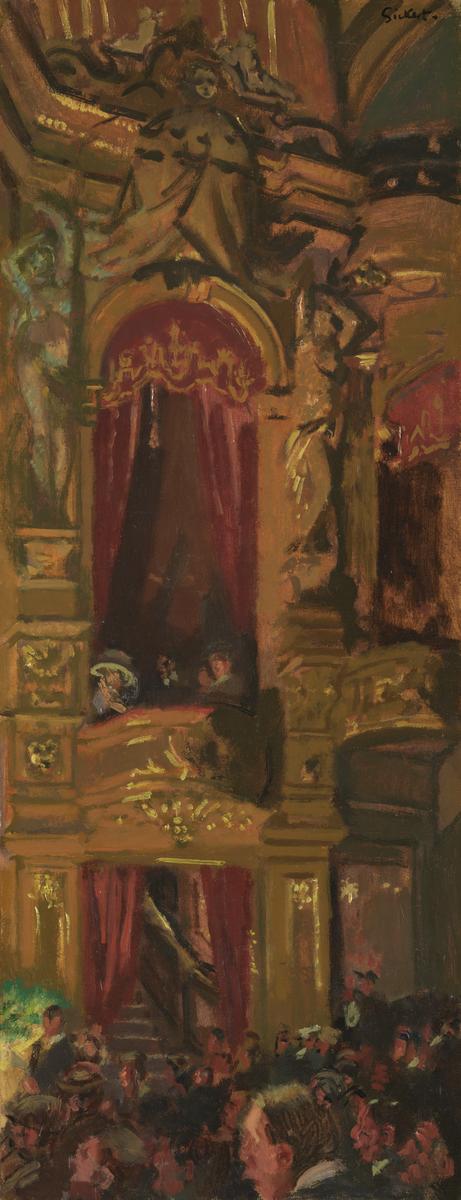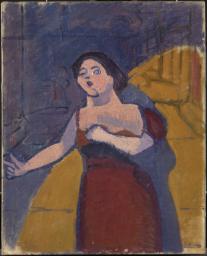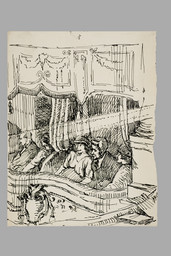Walter Richard Sickert The New Bedford c.1914-15
Walter Richard Sickert,
The New Bedford
c.1914-15
This elongated canvas shows a section of the New Bedford Palace of Varieties in Camden Town, London, to the right of the stage during a performance. The modernised New Bedford, which reopened in 1899, featured a motorised stage curtain as well as more mainstream entertainment than the bawdy delights once enjoyed by the working classes at the Old Bedford. Sickert depicts a trio of spectators in the middle of the canvas, framed by nude caryatids in glowing sculptural relief, who are socially, financially and physically elevated above the rest of the audience.
Walter Richard Sickert 1860–1942
The New Bedford
c.1914–15
Oil paint on canvas
914 x 356 mm
Inscribed by the artist ‘Sickert.’ in black paint top right
Bequeathed by Sir Edward Marsh through the Contemporary Art Society 1953
N06174
c.1914–15
Oil paint on canvas
914 x 356 mm
Inscribed by the artist ‘Sickert.’ in black paint top right
Bequeathed by Sir Edward Marsh through the Contemporary Art Society 1953
N06174
Ownership history
Bought by Sir Edward Marsh from the Carfax Gallery, London, November 1916 (14); bequeathed through the Contemporary Art Society to Tate Gallery 1953.
Exhibition history
1916
Paintings by Walter Sickert, Carfax Gallery, London, November 1916 (14).
1929
Exhibition of Contemporary British Art: Including the Collection of Sir Edward Marsh Esq., C.B., C.M.G., C.V.O., Whitechapel Art Gallery, London, October–December 1929 (267, as ‘The Old Bedford’).
1930
Jubilee Exhibition, Corporation Art Gallery and Museum, Cartwright Memorial Hall, Bradford, April–June 1930 (218, as ‘The Old Bedford’).
1931
Collection of Modern Paintings and Drawings Lent by Edward Marsh, Esq., C.B., C.M.G., C.V.O., Laing Art Gallery and Museum, Newcastle upon Tyne 1931 (11, as ‘The Old Bedford’).
1933
Retrospective Exhibition of Pictures by W.R. Sickert, Agnew, London, November–December 1933 (18).
1936–7
Empire Exhibition, British Council, Johannesburg Art Gallery, South Africa, September 1936–January 1937 (669).
1938
Paintings by Walter Richard Sickert, Arts Club of Chicago, January 1938 (10, as ‘The Old Bedford’), Carnegie Institute, Pittsburgh, February 1938 (26).
1940
British Painting Today, Contemporary Art Society, Bath, May–June 1940 (27).
1950
Sickert Exhibition, Hove Museum of Art, August–September 1950 (6).
1953
The Collection of the Late Sir Edward Marsh K.C.V.O., C.B., C.M.G., Contemporary Art Society, Leicester Galleries, London, May 1953 (76).
1960
Sickert: Paintings and Drawings, (Arts Council tour), Tate Gallery, London, May–June 1960, Southampton Art Gallery, July 1960, Bradford City Art Gallery, July–August 1960 (109).
1977–8
Sickert, (Arts Council tour), Ferens Art Gallery, Hull, December 1977–January 1978, Glasgow Art Gallery, February–March 1978, Plymouth City Museum and Art Gallery, April–May 1978 (42, reproduced).
1989–90
W.R. Sickert: Drawings and Paintings 1890–1942, Tate Gallery, Liverpool, March 1989–February 1990, Tate Gallery, London, July–September 1990 (13, reproduced on back cover).
1998
Two British Impressionists: Walter Sickert and Philip Wilson Steer, Norwich Castle Museum, January–April 1998 (28, reproduced).
2004
Walter Richard Sickert: The Human Canvas, Abbot Hall Art Gallery, Kendal, July–October 2004 (32, reproduced).
2008
Modern Painters: The Camden Town Group, Tate Britain, London, February–May 2008 (31, reproduced).
2010
The Art of Walter Sickert, The Lightbox, Woking, May–July 2010 (no catalogue).
References
1930
Joseph Duveen, ‘Thirty Years of British Art’, Studio, London 1930, reproduced p.46.
1939
Edward Marsh, A Number of People: A Book of Reminiscences, London 1939, p.364.
1941
Robert Emmons, The Life and Opinions of Walter Richard Sickert, London 1941, p.51.
1943
Lillian Browse and R.H. Wilenski, Sickert, London 1943, p.46.
1953
Christopher Hassall and Denis Mathews (eds.), Eddie Marsh: Sketches for a Composite Literary Portrait of Sir Edward Marsh, K.C.V.O., C.B., C.M.G., London 1953, reproduced pl.7.
1953
Contemporary Art Society Annual Report 1952–3, London 1953, [p.6].
1960
Lillian Browse, Sickert, London 1960, pp.78, 102.
1961
John Rothenstein, Sickert, London 1961, [p.26], reproduced pl.12.
1964
Mary Chamot, Dennis Farr and Martin Butlin, Tate Gallery Catalogues: The Modern British Paintings, Drawings and Sculpture, vol.2, London 1964, p.638.
1973
Wendy Baron, Sickert, London 1973, pp.153–4, 370.
1973
Sickert, exhibition catalogue, Fine Art Society, London 1973, no.63.
2001
David Peters Corbett, Walter Sickert, London 2001, p.71.
2004
Wendy Baron, ‘Dating Sickert’s Paintings of the New Bedford, Camden Town’, Burlington Magazine, vol.146, no.1214, May 2004, pp.329–30, reproduced fig.50.
2006
Wendy Baron, Sickert: Paintings and Drawings, New Haven and London 2006, no.298.2, p.342.
Technique and condition
This is one of a group of paintings and preparatory drawings of the New Bedford music hall. It is painted on a white pre-primed canvas bought from a local artist’ colourman, John B. Smith, from whom Sickert had previously purchased materials (see Tate T00164). The canvas has a plain close weave and appears to be made of a mixture of linen and cotton fibres. The cloth has been prepared with an absorbent ground consisting of a white primer, which is probably bound in a tempera medium (see Tate N05092). The artist has applied a wash of golden ochre onto the priming as an ‘imprimatura’, using either oil diluted with turpentine or tempera diluted with water. Sickert may have experimented with a tempera medium or may have replicated its effect by applying oil onto lean underpaint.
No drawing is evident on the prepared surface, despite the existence of a similar squared-up preliminary drawing. A darker yellow ochre and red ochre have been applied onto the toning layer and both areas of colour show some abrasion from rubbing (see also Tate N03182). This is then gone over with more thickly brushed paint, which retains the brushstrokes, and is unmodulated, having been pre-mixed on the palette. Details of the composition are painted in a more linear style and the diluted paint remains thin and broken with exposed underlayers and in places thin washes to modify the form. The tones are low except for some strong green and chrome yellow details and the paint generally lean, even in areas of impasto.1 The painting has a glossy varnish that detracts from the matt aesthetic of the paint, but it is not known whether the varnish was applied by the artist.
Stephen Hackney
July 2004
Notes
How to cite
Stephen Hackney, 'Technique and Condition', July 2004, in Nicola Moorby, ‘The New Bedford c.1914–15 by Walter Richard Sickert’, catalogue entry, May 2004, in Helena Bonett, Ysanne Holt, Jennifer Mundy (eds.), The Camden Town Group in Context, Tate Research Publication, May 2012, https://wwwEntry
Background
Sickert exhibited his first music hall painting, Le Lion comique (private collection),1 in 1887. Nearly thirty years later, he was still finding inspiration in London’s palaces of entertainment and in particular from his old haunt, the Bedford music hall in Camden Town. Around 1914 he was commissioned by his friend Ethel Sands to paint a series of pictures to adorn the dining room of her new house in Vale Avenue, Chelsea. Sickert declared himself ‘allumé’ (enlightened, illuminated) by the New Bedford and envisaged a set of large decorative panels depicting the interior of the music hall.2 Begun just before the outbreak of the First World War, his work on the paintings was sporadic and he was still faithlessly promising to bring the scheme to completion over four years later. Sands never received her dining room pictures, but a series of drawings, studies, paintings and etchings testify to Sickert’s intentions. It is with this body of work, and a group of earlier images, that Tate’s painting, The New Bedford, should be related.
The painting depicts a narrow, vertical, stalls to ceiling view of a section of the auditorium to the right of the stage crowded with the audience during a performance. The main focus of the work is a large private box, plushly decorated with red velvet hangings and gilt ornamentation, flanked on either side by two huge female caryatids. Three people, one of whom is a woman wearing a large hat, are seated in the box, high above other members of the audience massed in the circle below. A flight of stairs can be seen connecting the two levels. At the right of the painting there is a partial view of the adjacent smaller box and high above it the railings of the gallery at the top. A drawing in pencil inscribed ‘The Conductor – New Bedford’ c.1908 (private collection)3 confirms that the view shows the area immediately adjacent to the right of the stage and the orchestra pit.
The New Bedford
In previous accounts of Sickert’s music hall paintings it has been believed that the ‘Old’ Bedford music hall, built in 1861 on the site of a tavern and tea garden off Camden High Street, was burnt to the ground in 1896. It is not known where this myth originated, but recent research has revealed that no mention of a fire is to be found in council records or in local newspaper reports.4 Instead, it appears that the hall was pulled down in July 1898 for the purposes of expansion and redevelopment by the new proprietors, Benjamin Lucas and Ted Johnson.5 The building work was speedily completed within six months and the ‘New Bedford Palace of Varieties’ reopened on 6 February 1899.6
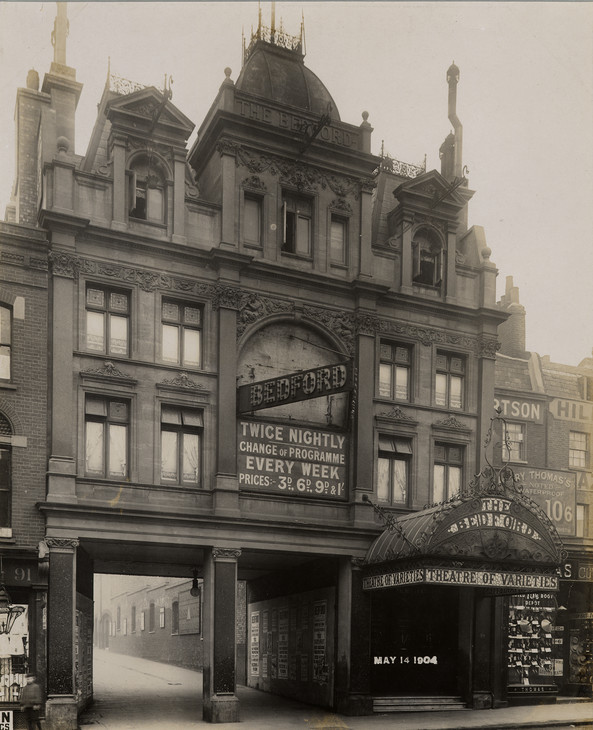
Ernest Milner 1862–1933
London Transport photograph of 91–97 Camden High Street, with the Bedford Theatre of Varieties 14 May 1904
278 x 227 mm
Camden Local Studies and Archives Centre
Photo © Camden Local Studies and Archives Centre
Fig.1
Ernest Milner
London Transport photograph of 91–97 Camden High Street, with the Bedford Theatre of Varieties 14 May 1904
Camden Local Studies and Archives Centre
Photo © Camden Local Studies and Archives Centre
Comparison with the newspaper account of the opening of the New Bedford in 1899 reveals how accurately Sickert’s painting reflects the appearance of the interior:
A special and very novel feature is the treatment of the private boxes, which although on circle level are approached solely from the stalls by handsomely decorated covered entrances through the ante-proscenium and thence by pretty little marble stairs. The style of decoration throughout is Louis Quatorze, with plentiful introduction of free figure paintings in friezes and panels, the effect of gold and soft tints being singularly harmonious when backed up by the rich ruby tints of the plush curtains and seating. A special feature is the proscenium arch and box elevation, which were actually designed by the architect. Standing on richly ornamented pilasters, two daintily modelled female figures of heroic size partially withdraw a magnificent canopy from the boxes, while above a group of cupids displays dramatic emblems.10
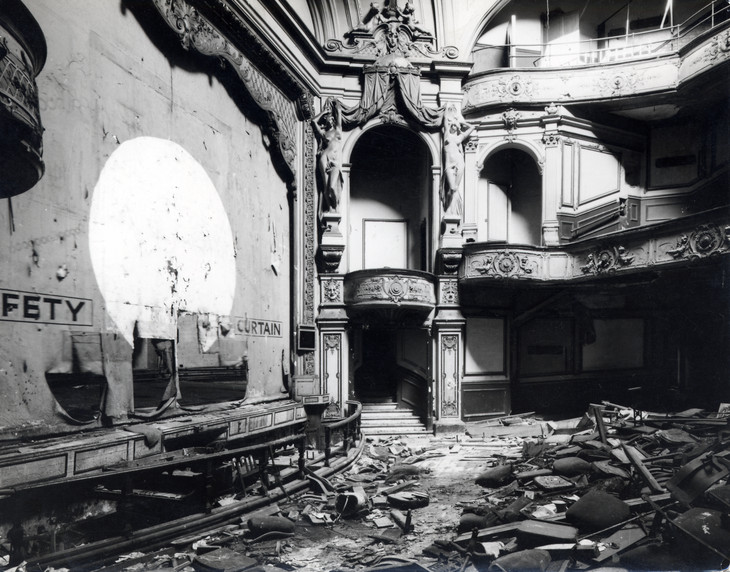
The Bedford Palace of Varieties after it closed in 1959
Photograph
Camden Local Studies and Archives Centre
Photo © Camden Local Studies and Archives Centre
Fig.2
The Bedford Palace of Varieties after it closed in 1959
Camden Local Studies and Archives Centre
Photo © Camden Local Studies and Archives Centre
Sickert and the Bedford
Sickert had a long-established practice of depicting the Bedford music hall originating in the 1880s and 1890s. Paintings such as Little Dot Hetherington at the Bedford Music Hall 1888–9 (private collection)13 and Vesta Victoria at the Old Bedford c.1890 (private collection)14 immortalised the female stars of the stage, while Gallery of the Old Bedford c.1895 (Walker Art Gallery, Liverpool)15 turned the focus onto the audience. The Bedford’s period of closure and redevelopment coincided with Sickert’s move to France in 1898, and it is likely that he did not visit the renovated building until after his return to London in 1905. From 1906 he started another series of music hall paintings, revisiting some of his old haunts in the process, such as the Middlesex music hall in Drury Lane. In December 1907, he wrote to his friend and patron, Mrs Hugh Hammersley: ‘I am returned to my old love the Bedford & I hope to illustrate the new building as I have already done the old one. My first drawing of the gallery there is dated 1886. Twenty years of (intermittent) fidelity is a record!’16
Sickert’s earliest painting recording the interior of the new building appears to be a small canvas in the collection of the Museum of London dating from around 1906–7.17 He went on to produce at least seven further paintings and two etched plates of the New Bedford.18 There are also a large number of preparatory drawings observing the audience and recording the various architectural elements of the theatre,19 which probably date from two separate periods of activity, c.1906–8 and c.1914–15.20 Seven drawings in the collection of the Walker Art Gallery concentrate on the caryatids and the decorative arches of the boxes that appear in Tate’s painting.21 These are all in pencil, chalk or pen and ink, on lined or graph paper. Sickert told Ethel Sands that his essential equipment for sketching in the Bedford included an account book with an ‘un-upsettable’ ink bottle.22
Date
In a Burlington Magazine article in 2004, Wendy Baron redefined the order in which Sickert’s paintings of the New Bedford were painted, correcting previous suggestions.23 A letter of 1907 from Sickert to Mrs Hammersley refers to work in progress on ‘a tall slice – six foot by twenty-eight inches including a sensational caryatid in plaster, lit from below’.24 Baron demonstrates that this must be The New Bedford, the large tempera and oil on canvas (1829 x 711 mm) now in the collection of Leeds City Art Gallery.25 The painting, which is closely related to Tate’s version, had previously been thought to be a finished panel for Sands’s Chelsea dining room dating from c.1914–16, but the earlier revised dating of c.1907–8 makes this impossible. In another letter, dated c.1910, Sickert invites Mrs Hammersley or her husband to view the version of a New Bedford subject they had commissioned from him. The Hammersley’s painting, The New Bedford (private collection),26 is a half-scale reprise of the Leeds painting. It is almost identical in appearance except that it depicts a slightly wider view, and there are small variations in the audience and the group seated in the box. Both paintings in turn relate to two, almost identical, detailed drawings, one published in the New Age in 1911 (whereabouts unknown),27 and a squared-up drawing (private collection).28 The drawings match the paintings in almost all respects of composition and detail, and are exactly half the size of the Hammersley version.
Like the Hammersley painting, Tate’s The New Bedford is half the scale of the Leeds painting, and it was originally thought that both were preparatory paintings for the larger canvas. Baron, however, argues that in this case Sickert worked from a large to a small scale. She groups all three paintings and the two detailed drawings together and argues that they must all have been executed between late 1907 and early 1911. This means that none of them can be related to the scheme for Sands’s dining room. Baron sketches out the known history of the dining room commission gleaned mostly from the correspondence between Sickert, Ethel Sands and Nan Hudson. A rough oil sketch in landscape format showing the upper circle and balcony level of the music hall (Mercer Art Gallery, Harrogate)29 reveals Sickert’s plans for the dining room. This view was to be repeated across three consecutive panels painted in tempera that were intended to cover the mantelpiece side of one wall. The middle section of the triptych (private collection)30 is slightly shorter in height to allow for its placement over the mantelpiece. Baron rightly concludes that although the Leeds New Bedford is roughly the same size as these three pictures, it reproduces a view on a different scale and therefore would have disrupted the overall coherence. She therefore also surmises that none of the images reproducing the vertical view of the New Bedford stage-side box were related to the dining room designs.
Baron’s argument is undoubtedly correct for the Leeds and Hammersley paintings, but it may not be the case that Tate’s New Bedford is also of an earlier date and not connected with the Sands dining room. In a letter to Hudson, Sickert wrote, ‘I have covered a big canvas 33 x 15 with oil paint for a finished study of the mantelpiece side of the room. That will incidentally make a saleable picture for Clifton.’31 The letter is undated but was probably written in the first half of 1914. Baron believes this letter refers to the oil sketch, The New Bedford (Mercer Art Gallery, Harrogate), which formed the basic design for the three consecutive panels of the dining room. However, the dimensions of this painting are 23 x 32 inches (585 x 810 mm) and it seems unlikely that Sickert would have misjudged the figures to such an extent. Furthermore, traditionally height comes before width when quoting size. It is possible, however, that Sickert is referring to the version now at Tate. Although the dimensions are not absolutely the same, it is closer in size (36 x 14 inches or 914 x 356 mm) and it looks a more finished and therefore ‘saleable’ subject than the Harrogate study. It was indeed sold through Arthur Clifton’s Carfax Gallery in 1916.
Sickert painted the three large panels for Sands’s dining room in around 1915 following the Harrogate sketch. The middle and left-hand panels are both now in private collections; the whereabouts of the final section is unknown.32 Although they form a coherent sequence intended to fit along the upper part of the dining room wall, this is probably not what Sickert originally intended. He wrote in a letter to Hudson:
I have arrived at a definite result about the decorations. I cannot fit the drawings I have into the spaces. They are not suited to them & were not intended for them & it would be a botch. I am not sorry as I have a profound instinct to do you something new. So I shall go tonight to the Bedford & make studies with the dining room in my mind of course, of course the only possible way. Why should I, with my fine instinct for filling a space, compile a patchwork of dead drawings.33
Sickert went back to the Bedford night after night to produce new designs for the panels. However, the letter to Hudson seems to imply that he had given serious consideration to reusing his earlier batch of New Bedford images, and that at one time he might have been considering using the vertical format of the Leeds and Hammersley paintings, rather than the horizontal panels he finally chose. Tate’s version is possibly a product of this early experimentation. The painting reproduces exactly the same view seen in the Leeds and Hammersley paintings and the squared-up drawings. The only slight difference occurs in the position of the spectators in the stage-side box (the absence of the woman in the flowered hat in the foreground of the left-hand corner has been previously noted, but in actual fact this figure is present although partially obscured).
There is a pendant to Tate’s painting in another vertical painting representing the full height of the theatre, The New Bedford (Natale Labia Collection, Cape Town).34 The Labia Collection painting shows the view to the right of Tate’s work, incorporating the same caryatid with left arm bent which stands to the left of the gallery box. Sickert reproduced the view in two etchings published in 1915, The New Bedford (The Large Plate) and The New Bedford (The Small Plate).35 Confirmation that the Labia Collection painting and these etchings were linked to the dining room scheme is found within Sickert’s regular correspondence with Ethel Sands, where he wrote in various letters, ‘Your room is amusing very much. Incidentally I am getting etchings out of the studies’,36 and ‘Out of your room has grown a plate which I have had printed today’,37 ‘a little bit of your dining room on copper’.38 In conclusion, therefore, it seems feasible that Tate’s painting is related to the Sands dining room scheme, and therefore retains its date of c.1914–15.
Dining room
In commissioning Sickert to decorate her dining room Sands may have been inspired by the decorative panels of Edouard Vuillard (1868–1940). Between 1892 and 1899 Vuillard completed a number of decorative schemes for private homes.39 Each set of panels was designed specifically with the patron and location in mind and their private nature meant that they were virtually unknown during Vuillard’s lifetime. However, one group of five oil paintings commissioned by Thadée Natanson was exhibited in Paris in 1895–6. Vuillard, whom Sands knew personally, generally chose subjects for decorations that reflected the social class of his patrons. Whether the idea of the theme for Sands’s dining room came from her or from the artist is not known, but the choice is rather a surprising one for Sands. The elaborate architectural features might have looked at odds in a domestic setting. Furthermore, while Sickert adored the common atmosphere and risqué performances of some of London’s smaller music halls, the tastes of Sands and her guests were likely to have been rather more refined. Her willingness to have her dining room transformed into a recreation of the New Bedford suggests that by the First World War, at least, music halls held a different appeal and reputation than when Sickert first started to paint them in the 1880s. While Sickert was living abroad between 1898 and 1905 the New Bedford had not only undergone a physical transformation but also seems to have become a respectable venue for rather more mainstream and popular family entertainment. Sickert told Sands that on Mondays he visited the Bedford ‘en famille’, taking his wife, Christine, and his mother.40
The art historian Anna Gruetzner Robins has discussed how Sickert’s earlier paintings of the Old Bedford, for example Gallery of the Old Bedford c.1895 (Walker Art Gallery, Liverpool),41 show spectators seated in ‘the gods’, the cheapest seats at the top of the auditorium. The gaudy, gilt interior was deliberately lavish to provide the working class clientele with a taste of extravagance and luxury, albeit rather vulgar and fake.42 The large mirrors were designed to show the poorer customers reflected within an atmosphere of unfamiliar opulence.43 Tate’s painting of The New Bedford adopts a more remote and detached standpoint than his earlier works. The viewer is positioned as though seated among the audience in the front stalls, but the narrow vertical format forces the gaze upwards and focuses on the party seated in the stage-side box, probably the most expensive seats in the house. Rather than portraying the camaraderie of the ‘boys in the gallery’, Sickert represents a more extravagant group of people, socially, financially and physically elevated above the rest of the audience.
Ownership
Tate’s painting of The New Bedford was purchased from the Carfax Gallery by Edward Marsh (1872–1953), and was considered by him to be one of the masterpieces of Sickert’s earlier period.44 The painting apparently hung in a recess at the side of the dining room chimneypiece.45 Marsh was an important figure in English cultural life in the first half of the twentieth century. By profession he was a civil servant and served as private secretary to a number of key politicians including Winston Churchill, Neville Chamberlain and Herbert Asquith. However, his formidable talents and catholic interests extended beyond politics, and at the beginning of the twentieth century he was a key supporter to a number of young writers including Rupert Brooke, Edward Blunden, Robert Graves, D.H. Lawrence and Siegfried Sassoon. As general editor of the serialised anthologies Georgian Poetry (1912–22), Marsh was instrumental in bringing many of these authors to prominence.
A love of modern (what became known as modernist) literature was matched by his interest in modern art, and during his lifetime he bought a large number of works by British artists. His purchases were funded from an unusual source. Marsh’s maternal great-grandfather was Spencer Perceval (1762–1812), the only British prime minister to have been assassinated. Perceval’s descendants received a National Grant of £50,000 as compensation, and it was money inherited from that fortune which enabled Marsh to ‘add a little jam to the bread-and butter of a civil servant’ and build up one of the most impressive private collections of modern British art.46

Duncan Grant 1885–1978
Parrot Tulips 1911
Oil paint on canvas
490 x 520 mm
Southampton City Art Gallery
© Estate of Duncan Grant. All rights reserved, DACS 2010
Photo © Southampton City Art Gallery, Hampshire, UK / The Bridgeman Art Library
Fig.3
Duncan Grant
Parrot Tulips 1911
Southampton City Art Gallery
© Estate of Duncan Grant. All rights reserved, DACS 2010
Photo © Southampton City Art Gallery, Hampshire, UK / The Bridgeman Art Library
Buying Old Masters in shops began to seem a sheeplike, soulless conventionalism. How much more exciting to back what might be roughly called one’s own judgement ... to go to the studios and the little galleries, and purchase, wet from the brush, the possible masterpieces of the possible Masters of the future! Besides, to buy an old picture did nobody any good except the dealer; whereas to buy a new one gave pleasure, encouragement and help to a man of talent, perhaps of genius. I still don’t see how anyone can hesitate between the two.47
Henceforth, modern art was Marsh’s passion, and although he never collected examples of abstract painting his enlightened and independent attitude represented a significant contribution to British art. Besides paintings by Sickert and Grant, Marsh also owned works by Camden Town Group members Walter Bayes, Charles Ginner, Spencer Gore, J.D. Innes, Henry Lamb, Wyndham Lewis and Augustus John.
Marsh’s acquaintance with Sickert predates his interest in contemporary art and stemmed from his close friendship with the artist’s younger brother, Oswald Sickert, who was in the year below Marsh at Trinity College, Cambridge. Marsh was first introduced to Walter Sickert over lunch at the Café Royal in 1892 and afterwards visited his studio.48 He later provided a lively description of him
then in the fine dandy flush of his elegant and witty prime, and full of Anecdotes of Painting ... Walter is still, as he then was, an imp. Only two or three years ago he introduced me, at a private view in the Leicester Galleries, to an American couple: ‘I want you to know Eddie Marsh – I was madly in love with him when he was a choir-boy.’ I didn’t know where to look, nor the Americans what to think; but fortunately no harm came of it.49
Marsh’s patronage of the arts extended beyond his own private interests and he was a long-standing member of the Contemporary Art Society (Chairman 1937–52), which greatly benefited from his association. During his lifetime he presented the Society with one hundred pictures from his own collection and, on his death in 1953, he bequeathed 250 more. Ten works from the bequest were presented to the Tate Gallery for which Marsh had served as a Trustee (1937–44, and Acting Chairman 1940–1). As well as The New Bedford, the bequest included Stanley Spencer’s Self-Portrait 1914 (Tate N06168) and Dancers c.1910–11, by Duncan Grant (Tate N06181).
Nicola Moorby
May 2004
Notes
Wendy Baron, Sickert: Paintings and Drawings, New Haven and London 2006, no.298.5; reproduced in Anna Gruetzner Robins, Walter Sickert: Drawings, Aldershot and Vermont 1996, fig.26.
Marian Kamlish, ‘The Rise and Fall of Sickert’s Dear Old Bedford’, Camden History Review, vol.19, 1995, p.33.
Camden and Kentish Town’s and St Pancras Gazette, 1 February 1899; quoted in Jean Aster, ‘History of the New Bedford Theatre, Camden Town: A Case Study of the Working Class “Recreational Revolution” during the Edwardian Era and beyond’, unpublished PhD thesis, University of London, May 1999, pp.15–16.
Walter Sickert, letter to Mrs Hugh Hammersley; quoted in Wendy Baron, ‘Dating Sickert’s Paintings of the New Bedford, Camden Town’, Burlington Magazine, vol.146, no.1214, May 2004, p.327.
Baron 2006, no.297; reproduced in Mireille Galinou and John Hayes, London in Paint: Oil Paintings in the Collection at the Museum of London, London 1996, p.385.
See Baron 2006, nos.298, 469–71 and 474; Ruth Bromberg, Walter Sickert Prints: A Catalogue Raisonné, New Haven and London 2000, nos.160–1.
Wendy Baron, ‘Dating Sickert’s Paintings of the New Bedford, Camden Town’, Burlington Magazine, vol.146, no.1214, May 2004.
Edouard Vuillard, exhibition catalogue, Montreal Museum of Fine Arts, National Gallery of Art, Washington and Royal Academy, London 2002, p.164.
Related biographies
Related essays
- Leisure Interiors in the Work of the Camden Town Group Jonathan Black, Fiona Fisher and Penny Sparke
- Empire and the City: Early Films of London Maurizio Cinquegrani
- A History of Camden Town 1895–1914 David Hayes
Related catalogue entries
Related archive items
Related audio
-
Tom Woottwell 1865–1941 performs 'What do you think I did?' recorded November 1908© Windyridge Music Hall CDs
How to cite
Nicola Moorby, ‘The New Bedford c.1914–15 by Walter Richard Sickert’, catalogue entry, May 2004, in Helena Bonett, Ysanne Holt, Jennifer Mundy (eds.), The Camden Town Group in Context, Tate Research Publication, May 2012, https://www

